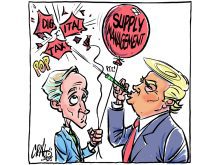LOST OPPORTUNITIES
Saskatchewan could have paired Saskatchewan wind power with Manitoba Hydro. Our premier chose instead to invest $1.2 billion of our tax money into a carbon capture and storage project that will generate a paltry 110 megawatts and burn 30 percent more coal.
We are also spending an unknown amount of our money into research on experimental small nuclear reactors.
The Americans saw the opportunity to pair their abundant wind power generating facilities with Manitoba Hydro. Minnesota Power and Manitoba Hydro have inked a deal under which electricity from excess wind power in North Dakota can be stored in Manitoba’s hydro reservoir when loads and prices are low, with the potential for selling that power back into the huge Midwest Independent Transmission System Operator at times when needs are high.
Read Also

Agriculture needs to prepare for government spending cuts
As government makes necessary cuts to spending, what can be reduced or restructured in the budgets for agriculture?
Manitoba is already a participant in MISO, with some of the lowest electricity rates in North America. The deal involves building a new $1 billion transmission line with the cost split.
Minnesota will build the U.S. portion and Manitoba the Canadian portion, and at the same time Manitoba is going to build new power dams that create more storage capability….
Saskatchewan could have chosen to go this route. We could have chosen to encourage production of renewables with feed in tariffs and a preference for local production.
Rural communities would have been stabilized as well as the incomes of farmers, ranchers and First Nations. Our greenhouse gas emissions per capita, the highest in Canada and among the highest of any jurisdiction anywhere, would have dropped. We could have built the connecting lines with Manitoba Hydro.
Wind and hydro are a great combination to provide a complimentary, stable electrical system with very low greenhouse gas implications.
Saskatchewan is going to double our wind power production — to a whole 200 MW. No manufacturing.
North Dakota has 1,680 MW of wind capacity with about 11,000 MW in various stages of planning and development.
Capital investment in wind power is about $3.3 billion with four manufacturing facilities providing over 1,000 jobs.
Lease payments to landowners are about $5 million annually….
Do you think our leaders have made wise decisions for the long-term benefit of Saskatchewan and wise use of our tax money?
Mike Bray,
Indian Head, Sask.
VISION FOR AGRICULTURE
Our government’s vision for agriculture is founded in the direction that the vast majority of producers are asking us to take.
After extensive industry consultations, last December our government introduced the Agricultural Growth Act. Within the act is a provision to finally move Canada toward implementation and ratification of UPOV 91, after 22 years of consultations.
The (National Farmers Union) is noticeably alone in (its) opposition to this bill, but this comes as no surprise. The NFU opposing innovation is about as shocking as spotting a Rider’s flag in Regina on game day.
The provisions to amend plant breeders’ rights under the Agricultural Growth Act have the solid support of a broad range of industry groups, including the Grain Growers of Canada, Prairie Oat Growers Association, Barley Council of Canada, Grain Farmers of Ontario, Western Canadian Wheat Growers Association, Cereals Canada and Western Barley Growers Association.
Farmers across Canada are em-bracing the opportunity opened up by this legislation to realize innovative, disease-resistant, higher-yielding varieties, while maintaining their right to save and clean their own seed.
To be clear, unlike UPOV 78, entrenched within the provisions of UPOV 91 is the farmer’s right to save and clear their own seed. Anyone who says otherwise is displaying a willful ignorance of the contents of this important bill.
As an exporting nation, our government is opening up markets for Canadian products around the world.
Farmers want us to get in line with our major trading partners on plant breeders’ rights, so they can have the innovative tools they will need to beat the competition, build a stronger farmgate and feed the world.
Gerry Ritz, agriculture minister,
LOOK AT ORGANIC
I am writing in response to Kevin Hursh’s column (Jan. 9 WP) “Prepare for more to succumb to anti-GMO pressure.”
I do not see this as an anti-GMO force winning. I see it as consumers making an informed decision. The consumer is not fearful; the consumer is well educated.
As Kevin pointed out, the customer is always right. If the customer wants non-GMO, maybe it is time we start supplying non-GMO products. The organic industry does not promote GMOs in production practices or processing.
The organic industry is strong, vibrant and growing because the consumer wants these products. The pace the consumer is demanding organic goods is outstripping the supply. Maybe it is time for farmers to take another look at organic agriculture.
The price spread between organic and conventional products has never been stronger. If you are a producer interested in supplying a product the consumer is demanding, talk to a progressive organic farmer in your area. I am sure he would be more than willing to answer any questions.
The organic sector needs more like-minded farmers to supply our customers. Maybe it is time to take another look at organic farming and start supplying the consumers with the products they want.
Brent Blackburn,
STUDY SEMI-RATIONAL
Re: (Agriculture minister) Gerry Ritz and the $1.5 million five-year grain movement study. The approach is semi-rational at best.
Gerry Ritz, prior to politics, did some small contractor work. He sold some ostrich eggs to farmer friends and acquainted persons. The Reform Party, with Preston Manning, came up with laissez-faire concepts such as a third railway structure to create competition.
Large farm operators were hell-bent on expansion and buying out their smaller acreage neighbours at the lowest possible cost. So big and you’ve got more grain to move. You’ve also walked into Gerry Ritz and his fascination with the unknown. He, Mr. Ritz, did not study laissez-faire economics, but if you believe ostrich eggs can turn into wealth?
The 2013 large crop started out as “let the good times roll” and starts to appear as “hard times starring you and me.”
(After) the listeria outbreak and patriarchal comments of “death by a thousand cold cuts,” why are expectations of transport efficiency still around?
Distress felt by many is opportunity for the opportunistic. The current state of grain movement is predictable and ideologically consistent in Gerry Ritz’s mindset.
Phil Dyck,
Langham, Sask.
GMO HEALTH CONCERNS
As a food consumer, food buyer and home vegetable gardener, I want unadulterated, unsprayed and organic or as close to that as possible.
I appreciate organic labels. I applaud organic farmers — certified quality — and their products and appreciate their hard work. I also want to support local growers. I thank The Western Producer for including the stories of organic producers to know they are out there. Keep up the stories, please.
I will not knowingly buy GMO product and thus would really like labels that show GMO free or GMO in content. It is hard to know if all canola, corn, sugar from beets and soy are from GMO plants.
Allergies can be a problem — I am speaking from experience. Is it the plant product, sprays or is it because it is GMO’d? Health is a big concern. I am not alone in my views. Research reports can be less than reliable.
So please, Mr. (Ted) Menzies (president of CropLife Canada), if you are going to promote GMO seed and product, then please also organize and promote labelling of the food product.
Peggy Gillis,
Okotoks, Alta.
















